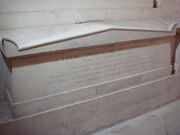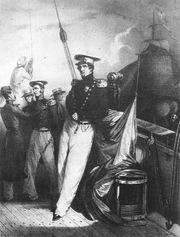Louis Antoine de Bougainville
| Louis Antoine de Bougainville | |
|---|---|
 Louis-Antoine de Bougainville, by Jean-Pierre Franquel |
|
| Born | 12 November 1729 Paris, France |
| Died | 31 August 1811 (aged 81) Paris, France |
| Nationality | France |
Louis-Antoine, comte de Bougainville (12 November 1729 – 31 August 1811) was a French admiral and explorer.
Contents |
Early career
Bougainville was born in Paris, the son of a notary, on either 11 or 12 November 1729. In early life, he studied law, but soon abandoned the profession, and in 1753 entered the army in the corps of musketeers. At the age of twenty-five he published a treatise on the integral calculus, as a supplement to De l'Hôpital's treatise, Des infiniment petits.
In 1755 he was sent to London as secretary to the French embassy, and was made a member of the Royal Society.
Seven Years' War (French and Indian War)

In 1756 he went to Canada as captain of dragoons and aide-de-camp to the Marquis de Montcalm. He took an active part in the capture of Fort Oswego in 1756 and in 1757 at the Battle of Fort William Henry. He was wounded in 1758 at the successful defence of Fort Carillon. He sailed back to France the following winter, under orders from the marquis to obtain additional military resources for the colony; during this crossing, he continued familiarising himself with the ways of the sea, skills that would later serve him well. Having distinguished himself in the war against Britain, he was rewarded with the cross of St Louis and returned to Canada the following year with the rank of colonel, but with little supplies to show for his trip - the metropolitan authorities having decided that "When the house is on fire, one does not worry about the stables".

During the pivotal year of 1759 (see Seven Years' War and French and Indian War), he participated in the defence of the capital of New France, the fortified Quebec City. With a small elite troop under his command, among which the Grenadiers and the Volontaires à cheval, he patrolled the north shore of the St. Lawrence River, upstream from the city, all summer long stopping the British several times from landing and thus cutting communications with Montreal. He was not given sufficient time, however, to rally his troops and attack the British rear when they successfully climbed up to the Plains of Abraham and attacked Quebec on September 13.
Following the death of the Marquis de Montcalm and the fall of Québec on 18 September - after the colonel's aborted attempt to resupply the besieged city - Bougainville was dispatched to the western front by his new commanding officer, the Chevalier de Lévis and attempted to stop the British advance from his entrenchments at Île-aux-Noix. He was among the officers who accompanied Lévis to Saint Helen's Island off Montreal for the last French stand in North America before the general capitulation of 1761. Of the war, Bougainville wrote in his journal: "It is an abominable kind of war. The very air we breathe is contagious of insensibility and hardness".[1]
Shipped back to Europe along with the other French officers, all deprived of military honours by the victors, Bougainville was prohibited from taking up any further active duty against the British under the terms of surrender. He spent the remaining years of the Seven Years' War (1761 to 1763) as a diplomat and helped negotiate the Treaty of Paris that eventually conceded most of New France to the British Empire.
Falklands settlement

After the peace, when the French government conceived the project of colonising the Falkland Islands, Bougainville undertook the task at his own expense. But the settlement he established in 1763, Port St. Louis, excited the jealousy of Britain and the Spanish government. Even if the French colony was more than 150 people, for financial motivations (he himself paid for many expeditions) and diplomatic reasons (Spain feared that the Falklands become a rear base to attack her Peruvian gold), Bougainville was ordered by the French government to dismantle his colony, to sell the islands to the Spanish (the King of Spain paid him 603 000 pounds for the islands). On 31 January 1767, he met in Rio de la Plata Don Felipe Ruiz Puente, commanding the frigate La Esmeralda and La Liebre (the hare) and future governor of the Malvinas Islands (Falklands), to take possession of the islands, and to evacuate French population. During this french time, British sailors tried to settle in the port de la Croisade in 1766, that they renamed Port Egmont. Bougainville wrote: "In December 1766, the frigate HMS Japan dropped anchor in Port Louis opposite to the fort. Captain Mac Bride landed, uttered threats and went away on the same day."
Port Louis is named after him.

In 1766 Bougainville received from Louis XV permission to circumnavigate the globe. He would become the 14th navigator in western history, and the first Frenchman, to sail around the world, and the completion of his mission would bolster the prestige of France following its defeats during the Seven Years' War. Bougainville left Nantes on 15 November 1766 with two ships: La Boudeuse and the Étoile. On board was the botanist Philibert Commerçon and his valet, later unmasked by the ship's surgeon as Jeanne Baré, possibly Commerçon's mistress; she would become the first woman known to circumnavigate the globe.
Tahiti
He saw islands of the Tuamotu group on the following 22 March, on 2 April saw the peak of Mehetea and famously visited the island of Otaheite shortly after and narrowly missed becoming their discoverer, unaware of a previous visit, and claim, by Samuel Wallis in HMS Dolphin less than a year previously. He claimed the island for France and named it New Cythera.
They left Tahiti and sailed westward to southern Samoa and the New Hebrides, then on sighting Espiritu Santo turned west still looking for the Southern Continent. On June 4 he almost ran into heavy breakers and had to change course to the north and east. He had almost found the Great Barrier Reef. He sailed through what is now know as the Solomon Islands that, due of the hostility of the people there, he avoided. He named Bougainville Island for himself. The expedition was attacked by people from New Ireland so they made for the Moluccas. At Batavia they received news of Wallis and Carteret who had preceded Bougainville.
Return to France
On 16 March 1769 the expedition completed its circumnavigation and arrived at St Malo, with the loss of only seven out of upwards of 200 men, an extremely low level of casualty, and a credit to the enlightened management of the expedition by Bougainville.
The legend begins
Describing Tahiti in his 1771 book Voyage autour du monde, Bougainville offered a vision of an earthly paradise where men and women live happily in innocence, away from the corruption of civilisation. His description powerfully illustrated the concept of the noble savage, and influenced the utopian thoughts of philosophers such as Jean-Jacques Rousseau before the advent of the French Revolution. Denis Diderot's book, Supplément au voyage de Bougainville, retells the story of Bougainville's landing on Tahiti, narrated by an anonymous reader to one of his friends: this fictional approach to Bougainville's expedition, along with the description of the Tahitians as noble savages, is meant to criticise Western ways of living and thinking.
American War of Independence
After an interval of several years, Bougainville again accepted a naval command and saw much active service between 1779 and 1782, including participating in the Battle of the Chesapeake.
Battle of the Saintes
In the memorable engagement of the Battle of the Saintes, in which Admiral George Rodney defeated the Comte de Grasse, Bougainville, who commanded the Auguste, succeeded in rallying eight ships of his own division, and bringing them safely into Saint Eustace. He was promoted to chef d'escadre and, on reentering the army, was given the rank of maréchal de camp.
After the peace of 1783 he returned to Paris, and obtained the place of associate of the Academy. He projected a voyage of discovery towards the North Pole but this did not meet with support from the French government.
Promotion and retirement

In 1787, he became a member of the French Academy of Sciences. He obtained the rank of vice-admiral in 1791; and in 1794, having escaped from the Reign of Terror, he retired to his estate in Normandy. Returning to Paris, he was one of the founding members of the Bureau des Longitudes. In 1799, Napoleon I made him a senator, and in 1808, a count of the Empire and member of the Legion of Honour. He died in Paris on the August 31, 1811. He was married and had three sons, who all served in the French army or navy.
Legacy

Bougainville's name is given to the largest eastern island of Papua New Guinea; and to the strait which divides it from the island of Choiseul. It is also applied to the strait between Mallicollo and Espiritu Santo islands of the New Hebrides group. In the Falklands, Port Louis, and "Isla Bougainville" (Lively Island's Spanish name) commemorate him.
The genus of South American climbing shrubs with colorful bracts, Bougainvillea, is named after him.
Thirteen ships of the French Navy have been named in his honour, see French ship Bougainville.
Notes
- ↑ Cave, p.11
References
- Waggaman, Beatrice Elisabeth. Le Voyage autour du monde de Bougainville: droit et imaginaire. (Nancy: Presses universitaires de Nancy), 1992. 286480476X.
- Alfred A. Cave The French and Indian War2004 Greenwood Press ISBN 031332168X